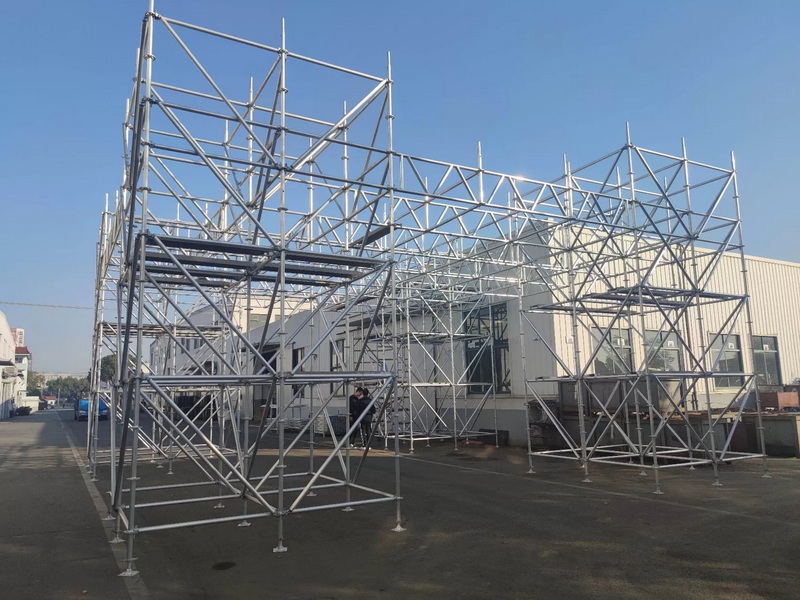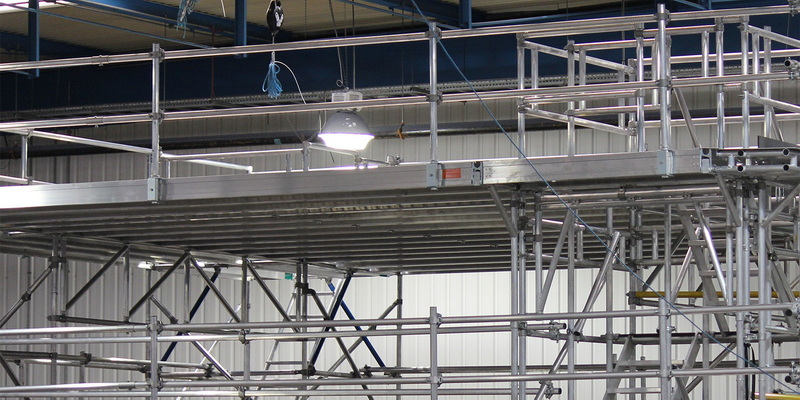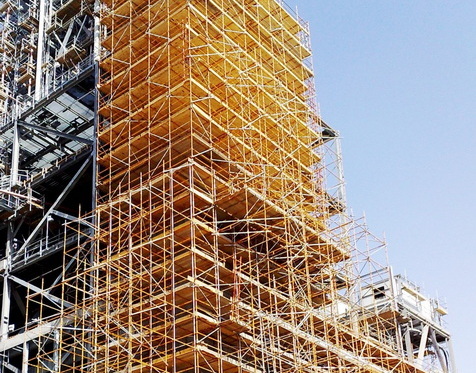Content Menu
● What is Aluminum Pole Scaffolding?
● Load-Bearing Capacity of Aluminum Pole Scaffolding
>> Understanding Scaffold Load Ratings
>> Aluminum Scaffolding Load Capacity
>> Factors Affecting Load Capacity
● Advantages of Aluminum Pole Scaffolding
>> Lightweight and Portable
>> Corrosion Resistance
>> Durability and Stability
>> Versatility and Safety Features
>> Environmental and Economic Benefits
● Practical Applications of Aluminum Pole Scaffolding
>> High-Rise Construction
>> Facade Work and Maintenance
>> Heavy-Duty Construction Tasks
>> Industrial and Commercial Use
● Comparison: Aluminum Pole Scaffolding vs. Steel Scaffolding
● Safety Considerations for Heavy Loads
● Maintenance Tips for Aluminum Pole Scaffolding
● Conclusion
● FAQ
>> 1. What is the maximum load aluminum pole scaffolding can support?
>> 2. Is aluminum pole scaffolding safe for use at high elevations?
>> 3. How does aluminum pole scaffolding compare to steel scaffolding in terms of strength?
>> 4. Can aluminum scaffolding be used outdoors in harsh weather conditions?
>> 5. What safety features are included in aluminum pole scaffolding systems?
● Citations:
Aluminum pole scaffolding is a widely used system in construction and maintenance due to its lightweight nature and versatility. However, a key question often arises: Can aluminum pole scaffolding support heavy loads? This article thoroughly examines the load-bearing capabilities, safety standards, practical applications, and advantages of aluminum pole scaffolding.

What is Aluminum Pole Scaffolding?
Aluminum pole scaffolding consists of vertical and horizontal aluminum poles combined with platforms to create elevated work areas. It is favored for its portability, corrosion resistance, and ease of assembly compared to traditional steel scaffolding.
Aluminum pole scaffolding is often modular, allowing workers to adjust the height and width of the scaffold according to the specific needs of the project. This flexibility makes it suitable for a wide range of construction and maintenance tasks.
Load-Bearing Capacity of Aluminum Pole Scaffolding
Understanding Scaffold Load Ratings
OSHA mandates that scaffolding and its components must support their own weight plus at least four times the intended load, including workers, tools, and materials. Scaffold planks and platforms are classified into three load capacity categories:
- Light-Duty: Supports up to 25 pounds per square foot (psf).
- Medium-Duty: Supports up to 50 psf.
- Heavy-Duty: Supports 75 psf or more.
Aluminum Scaffolding Load Capacity
Aluminum pole scaffolding typically supports loads in line with these categories. According to industry data, aluminum scaffolding platforms can bear between 225 kg to 300 kg per platform, roughly equivalent to the weight of two workers plus tools. A full aluminum scaffold tower can safely carry loads up to approximately 700 kg.
The Alum-A-Pole system, a leading aluminum pole scaffolding product, is rated for:
- A maximum working height of 50 feet (shoulder height).
- Load capacity of up to 500 lbs per scaffold stage for two workers.
Factors Affecting Load Capacity
Several factors influence the actual load capacity of aluminum pole scaffolding:
- Pole Diameter and Wall Thickness: Thicker poles with larger diameters can bear heavier loads.
- Quality of Joints and Connectors: Secure locking mechanisms and reinforced joints enhance load-bearing ability.
- Platform Material: Aluminum platforms are stronger and more durable than wooden planks.
- Assembly Quality: Proper setup according to manufacturer guidelines ensures maximum strength.
- Ground Conditions: Stable, level ground with appropriate base plates is critical for load distribution.
Advantages of Aluminum Pole Scaffolding
Lightweight and Portable
Aluminum poles weigh significantly less than steel, with a 12-foot aluminum pole weighing about 26 lbs compared to a heavier steel counterpart. This ease of handling reduces labor fatigue and speeds up assembly and disassembly.
Corrosion Resistance
Aluminum naturally resists rust and corrosion, making aluminum pole scaffolding ideal for outdoor use in various weather conditions without the need for protective coatings.
Durability and Stability
Despite its light weight, aluminum offers excellent structural strength. Reinforced joints and locking mechanisms ensure stability even under heavy loads. The Alum-A-Pole system includes foldable braces, rigid braces, and safety nets to enhance scaffold integrity.
Versatility and Safety Features
Aluminum pole scaffolding can be configured horizontally and vertically with joinable stages, allowing for flexible scaffolding widths and heights. Safety features include:
- Non-slip platforms
- Guardrails and toe boards
- Secure locking clamps
- Safety nets to prevent falls
Environmental and Economic Benefits
Using aluminum pole scaffolding can reduce environmental impact due to its recyclability and longer lifespan compared to wooden scaffolding. Economically, the ease of assembly and reduced labor costs translate into project savings.

Practical Applications of Aluminum Pole Scaffolding
High-Rise Construction
Aluminum pole scaffolding is well-suited for high-rise jobs due to its lightweight nature and ability to reach heights up to 50 feet safely. The Alum-A-Pole system is OSHA-approved for such applications.
Facade Work and Maintenance
Its adaptability allows workers to access building facades for window installation, painting, and repairs efficiently and safely.
Heavy-Duty Construction Tasks
Heavy-duty aluminum scaffolding can support the weight of workers, tools, and materials necessary for concrete work, electrical installations, and other demanding tasks.
Industrial and Commercial Use
Aluminum pole scaffolding is also used in industrial plants and commercial buildings for maintenance, cleaning, and inspection tasks, where quick setup and mobility are essential.
Comparison: Aluminum Pole Scaffolding vs. Steel Scaffolding
| Feature | Aluminum Pole Scaffolding | Steel Scaffolding |
| Weight | Approximately 25% lighter | Heavier and more cumbersome |
| Corrosion Resistance | Naturally corrosion-resistant | Prone to rust without treatment |
| Load Capacity | Supports heavy loads up to 500+ lbs/stage | Comparable but heavier |
| Assembly Ease | Quick assembly with locking clamps | Slower due to heavy components |
| Maintenance | Low maintenance due to corrosion resistance | Requires regular maintenance |
| Longevity | Longer lifespan outdoors | Shorter lifespan if exposed to elements |
Safety Considerations for Heavy Loads
- Always inspect aluminum pole scaffolding components for damage before use.
- Use proper base plates or sill plates on soft ground to ensure stability.
- Secure scaffolding to the building with braces and safety chains.
- Do not exceed manufacturer's load ratings.
- Follow OSHA guidelines for scaffold erection and use.
- Train workers on proper scaffold use and load limits.
- Regularly maintain and inspect scaffolding for wear and tear.
Maintenance Tips for Aluminum Pole Scaffolding
To maximize the lifespan and safety of aluminum pole scaffolding:
- Clean aluminum components regularly to remove dirt and debris.
- Store scaffolding indoors or under cover to prevent damage.
- Lubricate locking mechanisms to ensure smooth operation.
- Replace any damaged or bent poles immediately.
- Check for loose bolts and tighten as necessary.
Conclusion
Aluminum pole scaffolding can indeed support heavy loads safely and efficiently. Its high strength-to-weight ratio, corrosion resistance, and versatile design make it a superior choice for many construction and maintenance projects, including heavy-duty and high-rise applications. Systems like Alum-A-Pole demonstrate that aluminum scaffolding can meet stringent OSHA standards for load capacity and working height, providing a safe, durable, and cost-effective solution for elevated work platforms.
The combination of lightweight portability, ease of assembly, and robust load-bearing capacity makes aluminum pole scaffolding an excellent investment for contractors seeking safety, efficiency, and longevity in their scaffolding systems.

FAQ
1. What is the maximum load aluminum pole scaffolding can support?
Aluminum pole scaffolding systems typically support up to 500 lbs per stage, with some heavy-duty platforms rated for 75 pounds per square foot or more, accommodating two workers plus tools and materials.
2. Is aluminum pole scaffolding safe for use at high elevations?
Yes, aluminum pole scaffolding like the Alum-A-Pole system is OSHA-approved for working heights up to 50 feet, featuring braces and safety nets to ensure stability and worker safety.
3. How does aluminum pole scaffolding compare to steel scaffolding in terms of strength?
While steel is generally stronger by weight, aluminum scaffolding offers comparable load capacity with the advantage of being lighter, corrosion-resistant, and easier to handle.
4. Can aluminum scaffolding be used outdoors in harsh weather conditions?
Yes, aluminum's natural resistance to corrosion makes it ideal for outdoor use in rain, humidity, and even coastal environments without significant degradation.
5. What safety features are included in aluminum pole scaffolding systems?
Common features include non-slip platforms, guardrails, toe boards, secure locking clamps, foldable and rigid braces, and safety nets to prevent falls and scaffold collapse.
Citations:
[1] https://biljax.com/scaffold-plank-load-capacity
[2] https://lynnladder.com/product/alum-a-pole-scaffolding-system/
[3] https://www.wm-scaffold.com/aluminium-scaffolding/
[4] https://adto-scaffold.en.made-in-china.com/product/HxkrlsJVsAWD/China-Heavy-Duty-Adjustable-Aluminium-Scaffolding-with-Pneumatic-Wheels-for-Kwikstage-Scaffold-System.html
[5] https://www.ajbuildscaffold.com/aluminum-scaffolding
[6] https://alumapole.com/scaffoldmain.html
[7] https://industrialladder.com/pump-jacks-powerpole-systems/alum-a-pole-pump-jacks/
[8] https://www.youtube.com/watch?v=WM4rp17XH3c






















